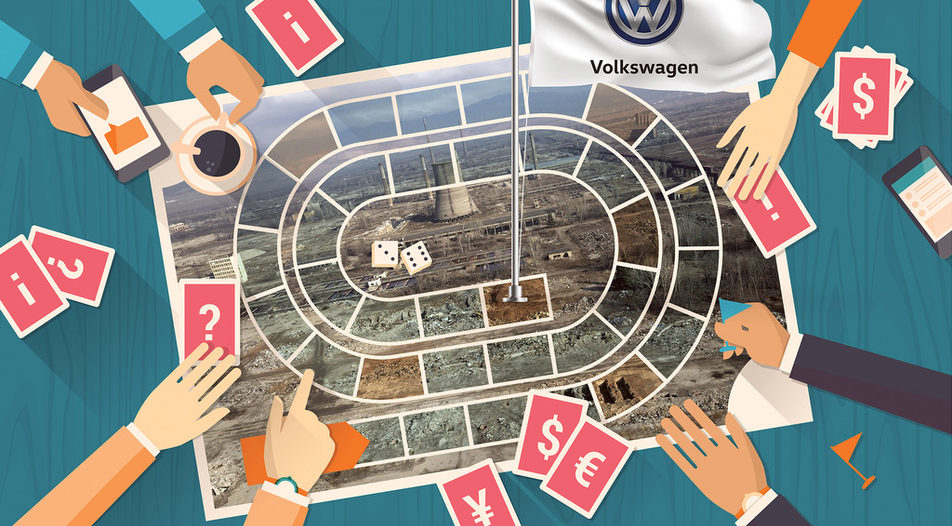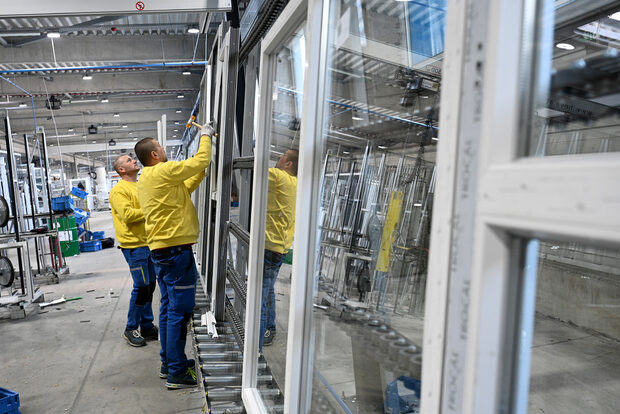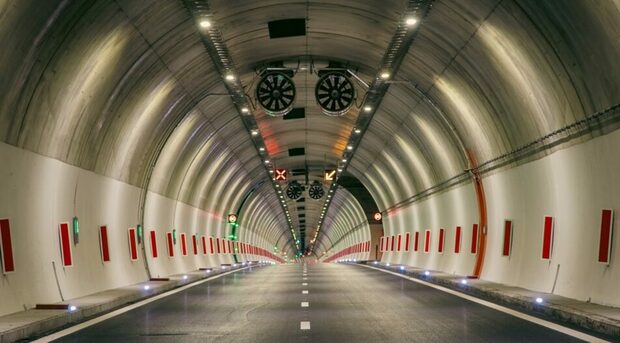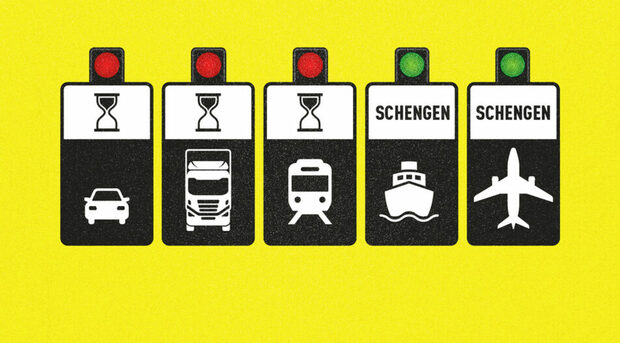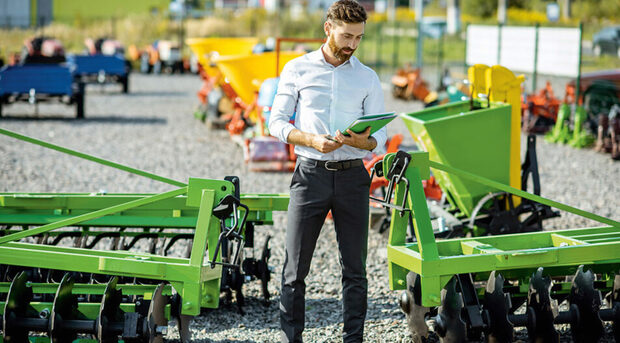The road to Kremikovtzi is still as potholed as it has been over the past twenty years. Holes and a rotten safety barrier stand between deserted buildings and a high fence warning that "Guard Dogs are on Patrol". Only the smokestacks remind us that this was once the site of a huge steel mill more than a decade ago.
The apocalyptic landscape on the eastern outskirts of Sofia, however, now has a hope for resurrection. Bulgaria is negotiating to attract a car producer - not just anyone, but the world's largest, the Volkswagen Group. And Kremikovtzi is one of the two sites where a manufacturing plant can be built. If everything goes to plan, cars will start rolling off the production line in 2022.
Such an investment will not only mark a huge injection in Bulgaria's GDP at a time of slowdown for the European economy. It will also boost the country's image no end, raising it to new heights in the competition for investors. Although Bulgaria has supplied a variety of automotive components for years, this would mark its entry into the veritable Big Time - a fully-fledged car factory. And, last but not least, car manufacturing will propel the labor market across the country and open up many new opportunities.
Volkswagen's potential arrival is not entirely dependent on the Bulgarian authorities. But it will not happen without their involvement. Sofia has no experience negotiating with investors on such a scale, so extra efforts will be required.
Mega-plant
Volkswagen announced at the end of 2018 that it was considering a site for a new factory in Eastern Europe. It will be of the so-called multibrand type, i.e. producing cars from different brands in the group's portfolio, including VW, Audi, Skoda, SEAT and others.
The idea is to assemble initially two models at the new unit in Eastern Europe: Skoda Karoq and SEAT Ateca. Their current production in Skoda's factory in Kvasiny, the Czech Republic, will be transferred to the new unit. The relocation is part of VW's overall strategy of shifting to manufacturing more and more electric vehicles in its factories in Emden and Hannover.
As news broke that the production lines from the Skoda factory were to be moved, speculation initially mounted that a new location for the manufacturing of the Czech brand was being sought. But the new factory will make models from the entire spectrum of the Volkswagen Group. Hence it is still uncertain who will run the facility - Skoda or VW's passenger car division, as the powerful German trade union IG Metall demands.
The gigantic auto group's plans were kept hushed at first. But news of this significance could not remain under wraps in a region like the Balkans for long. According to Capital sources, the direct capital investment would top 1.4 billion euro and create about 5,000 jobs, including hundreds of engineers, and subsequently thousands more in supporting activities such as supplier and service industries.
Volkswagen has stringent requirements for the land and the infrastructure around its new factory. The company is seeking an area of about 400 hectares, with access to high capacity power supply (at least 20 MW), a gas transmission network, water supply and a highway. It also must be near an airport and a railway and meet certain eco-requirements. The plant will cover the entire process of producing, testing, assembling and storing of the vehicles. An engineering team of several hundred specialists will be employed at the new plant.
Little time remains to select a location for the new VW plant: the final decision is to be taken by the end of April or in early May. The idea is to start manufacturing there in 2022.
Factory or death
Such a project is, of course, a salivating prospect for governments across the region. For comparison, an investment of this magnitude equals the total foreign investment in Bulgaria throughout 2017 and the first half of 2018.
Therefore, when negotiating such projects in the European Union (indeed anywhere), the automotive giants have a very strong hand. They can be sure that if they do not seal the deal in one place, they will quickly do so with the government of another country. According to Capital sources, direct competitors of Bulgaria for the plant are Romania and Serbia.
Such limited competition is good for Bulgaria because the leading country in the region in terms of automotive manufacturing - Turkey, is not in the race and because Bulgaria has advantages in terms of wage costs and labor availability. On the downside for Bulgaria, Romania and Serbia both have experience in automotive production at similar plants and, in addition, Serbia is not bound by EU state aid rules.
A similar project has not been realized in Bulgaria's modern history. It is inordinately more complex and expensive than the unfortunate attempts of recent decades to make cars in the country. The assembly of Britain's Rover Maestro in Varna lasted just one year in the mid-1990s and China's Great Wall plant in Bahovitsa, near Lovech, never even reached medium capacity before it was finally closed.
According to Capital sources, the Bulgarian government has set up an inter-ministerial working group to negotiate with the investor. At this stage, talks are ongoing with Volkswagen's consultant Jones Lang LaSalle fund (JLL) which is responsible for selecting the site of the future plant. The criteria for the site are already very strict and few locations in Bulgaria could host such a mega-project. Locations around Sofia, Plovdiv, Burgas and Northwestern Bulgaria have been scouted and two options shortlisted - the site of the former Kremikovtsi steel mill and a plot of land in the Rakovski Industrial Zone near Plovdiv, part of Trakia Economic Zone.
Sofia vs Plovdiv
According to Capital sources, the most important stipulations of the VW Group concern the land plot essentials, what state aid (incentives) the investor will receive, and labor availability in the area of the future plant.
The Kremikovtzi site meets many preliminary requirements. As an industrial property consultant said, "over the years all Sofia's industrial infrastructure has been developed around this plot.". It has access to industrial electricity supply and a gas network and rail transport; it is near a highway and an airport. Currently, the owner of the plot covering about 770 hectares is Bulgaria's First Investment Bank (Fibank).
Evidence of potential preparations to host an investor is the recently concluded property deal between Fibank and Austrian-based Soravia Real Estate Development. With it, the bank provides Soravia with a little over 300 hectares of its Kremikovtzi plot of land through a financial leasing contract. Since such deals are far from commonplace, it has only reinforced rumors that the land would be offered to the expected big investor through an intermediary.
This will be a feasible option for all parties involved: Fibank will receive a financial injection for its land that has not been used effectively so far; VW or the government will be able to work on a potential deal through an intermediary, and the former Kremikovtzi area will be revived. The disadvantage of this option is that the investment - potentially the biggest in decades, will be made in the most economically developed region of Bulgaria, widening the gap between Sofia and the rest of the country. What's more, the site must be additionally cleared up and re-cultivated.
The land in Rakovski Industrial Zone is owned by Bulgaria's Sienit Holding, which is developing the five industrial areas around Plovdiv and has experience working with many investors in the region, including suppliers of parts for the automotive industry. Infrastructure at the site needs much more investment, such as railway access or two sources of electricity supply, to bring it up to the standards of the VW Group, but it is idle and ready for construction. VW's arrival would sharply affect the dozens of major manufacturers in the area, triggering a sharp rise in salaries and even fiercer competition for employees.
Government incentives
Bulgaria and the other potential host countries had until the end of February to fill in a very detailed document demanded by the investor -a Request for Proposal (RFP). It must provide details of the offer which the country is putting on the table. They include both state aid and additional commitments in a number of areas - infrastructure, workforce and training - including finer points such as air cleanliness, medical centers and kindergartens nearby, as well as a granted number of police officers around the plant.
Outside the offer of the most suitable site, the most challenging competition among candidate countries will be in the area of the incentives the governments can provide.
For investments of this magnitude, this means direct repayment of a percentage of the invested capital. All sources approached by Capital have been extremely circumspect on this topic and requested anonymity because of the ambiguities involved. They say the final decision will depend on the details of the assistance which a government will propose.
Sofia is still considering what incentives it can proffer to the potential investor. Among them could be a cheap lease of the land after the government has bought it from its current owners. In the RFP the government can point out that Bulgaria has already begun the construction of a highway to Serbia. In the most optimistic version, the plan for building a high-speed highway from Botevgrad to Vidin, on the Danube River opposite Romania's Calafat, which will be ready for the potential opening of the car factory in 2022, can be put on the table. This will be a good alternative to the route to Central Europe through Serbia, but there are many uncertainties around this highway.
An international consultant with experience in such negotiations has indicated that everything hinges on the government's ability to "package" into its offer certain investments in infrastructure that will benefit the whole area alongside the specific project, so that they may not be classified as state aid.
Some of the incentives will certainly be in cash. In the most recent case, Slovakia paid 125 million euro to Jaguar Land Rover for an investment of the same scale (1.4 billion euro). Unofficial sources from Romania indicate that the country is ready to provide some 300 million euro of comprehensive state aid under various guises.
It is unclear how much such support can pass European Commission control without obstructions. In its investigation of the Slovakia-Jaguar case, the Commission said that the incentives were in line with EU state aid rules because they contribute to investing in a disadvantaged region without unduly distorting competition. The incentives also helped Jaguar to prefer investing in Europe over Mexico. In such cases, according to two official sources, state aid in EU varies between 15 and 40% of the total investment, depending on the status of the region in which it is made. This also is an element of the Sofia-Plovdiv rivalry: because it is part of the Southwestern region, the capital can receive up to 25% state aid. This would have been impossible if the city had stood alone as a region because it would have been above the average level of development in the EU. However, Plovdiv is entitled to state aid of up to 50% of the investment.
The Volkswagen effect
Another issue of concern to the investor is the availability of manpower in the selected area. Here lies Bulgaria's great advantage. In the words of several consultants who are working in Central and Eastern Europe, not many workers are available in the markets of the Czech Republic and Hungary. This also applies to some places in Romania, leaving Bulgaria as a natural pool for such projects.
Moreover, disputes already abound about salaries in other markets, as demonstrated by the strikes at the Audi plant in Hungary earlier this year and the VW plant in Slovakia in 2017. The average monthly salary there now stands at 1,500 euro. A salary of 1,000 euro for a novice in Bulgaria would be more than twice the standard in the industry.
The wider topic is why such an investment would be important for Bulgaria as a whole. Sofia and Plovdiv are both fully developed markets with very low unemployment and many active production capacities. The industrial zone near Plovdiv is already heaving under great regional demand and finding 5,000 employees will be difficult. Employees are transported from neighbouring cities like Haskovo. An example is the decision of Sensata Technologies Bulgaria to stop the expansion of its manufacturing plant in Plovdiv and grow its business at its other plant - in Botevgrad.
The emergence of a plant with 5,000 employees will have several tangible repercussions. First, it will lead to a rise in the average salary in at least a few sectors that will want to retain their staff. Some investors will probably leave and others will suffer, but the overall effect should be highly stimulating.
Once a giant like VW has arrived, leading suppliers and a number of smaller companies associated with it will follow. According to Georgi Angelov, Senior Economist at Open Society Institute - Sofia, the one-off investment is large and will have a beneficial knock-on effect on Bulgaria's GDP. More important still is the added value it will generate in the economy. "This is the first occasion on which we can realistically expect to attract such an investment," Angelov said.
He pointed out that every car is a capital-intensive, skill-based, high value-added product. According to independent research, a dollar invested in the auto industry increases gross domestic product by an average of three dollars. And examples like Slovakia show that where a large manufacturer comes, others usually follow.
In short, Bulgaria is on the verge of a real potential breakthrough. Whether it will succeed remains to be seen in the coming months.
Ivaylo Mishev, Head of Development at Arco Vara Bulgaria: Real estate market: are prices going to stabilize or fall?
What was the major event in your business sector in Bulgaria in the last quarter?
A massive increase in issued residential construction permits in Sofia during 2018 (1.8m m2 total built-up area; 14,700 units), a nearly threefold increase compared to 2017 (0.66m m2 total built-up area; 5,340 units). The picture looks similar in other big Bulgarian cities. While such numbers seem to be telling a story of the never-ending favourable economic climate, affordable financing, and rising incomes, they should rather be considered the pinnacle of eight years of constant growth after the 2009-2011 slump. Common sense dictates that demand for newly built residential can't triple over a year in a country with an ageing population, limited FDI inflow, and relatively constant (and modest) population numbers and income growth in big cities. Sales prices and construction costs have reached record levels, supported in part by non-professionals-turned-developers overnight, seeking the quick and attractive returns from the story above.
What do you see as the next major development in your company's business in the forthcoming quarter or further?
On one side there are the looming interest rate hikes, worldwide economic slowdown, ticking bombs (Italy, Brexit, trade war, Trump in general), EU elections and the expected populist surge - namely the global unknowns. On another and on a more local level - an upcoming outright disproportion between the supply of and demand for newly built homes (see above), banks taking a more conservative attitude in mortgage financing after a warning call by the regulator, local elections in October, lack of administrative reform and vast bureaucracy on both state and city levels, abnormally low unemployment in construction and the real estate sector. Put these together and in a good case scenario, we are to witness market and price stabilization and modest or no growth in the next couple of years. In a worst-case scenario, a correction should be expected, including sell-offs and construction price decreases, some people losing their jobs, others defaulting on their loans (developers too), and some development projects not getting finished.
Ivaylo Mishev holds BSc and MBA degrees from the University of Portsmouth and University of Sheffield respectively. He started as Project Manager in Arco Vara's Bulgarian development unit in 2007 and has been heading it since 2010.
The road to Kremikovtzi is still as potholed as it has been over the past twenty years. Holes and a rotten safety barrier stand between deserted buildings and a high fence warning that "Guard Dogs are on Patrol". Only the smokestacks remind us that this was once the site of a huge steel mill more than a decade ago.
The apocalyptic landscape on the eastern outskirts of Sofia, however, now has a hope for resurrection. Bulgaria is negotiating to attract a car producer - not just anyone, but the world's largest, the Volkswagen Group. And Kremikovtzi is one of the two sites where a manufacturing plant can be built. If everything goes to plan, cars will start rolling off the production line in 2022.








